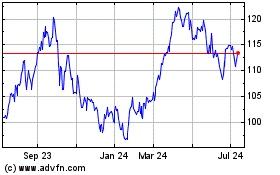By Sarah Kent and Robb M. Stewart
The world's largest energy companies are sidelining big ideas
that they touted just a couple of years ago as the future of the
industry.
From Australia to the U.S. Gulf Coast, the casualties include
ultra-deep-water drilling projects, huge boats that serve as
floating liquefied natural gas factories and technology that could
drastically reduce emissions from burning fossil fuels. Royal Dutch
Shell PLC, Chevron Corp. and Australia's Woodside Petroleum PLC are
among the big companies to pull back or delay ambitious
projects.
Shell hammered home the message on Wednesday after reporting
first-quarter profits that were down 83% from the same period a
year before. The Anglo-Dutch oil giant said it would cut its
capital spending budget another 10%, to $30 billion this year.
"To be brutally honest, any large new greenfield investment
whether floating LNG, deepwater or elsewhere is under very strict
critical review for cost levels and return simply because of where
the industry is," Shell Chief Financial Officer Simon Henry said in
a conference call.
As of March, the oil industry has deferred or canceled $270
billion in projects since crude prices began crashing nearly two
years ago, according to estimates from Norway-based consultancy
Rystad Energy. The bulk of those spending cuts have involved
high-tech projects once seen as crucial to sustaining global energy
supplies.
It is a dramatic turnaround from the last decade when surging
demand for oil and dwindling resources sent crude prices soaring
and big energy companies pushing into new frontiers regardless of
the cost.
According to information and analytics firm IHS Inc., the
oil-and-gas industry spent about 15% less on research and
development in 2015, when crude oil prices averaged roughly $50 a
barrel, compared with 2014, when prices averaged close to $100 a
barrel.
"We see a pullback from customers on really complex projects,"
said Kishore Sundararajan, chief technology officer at GE Oil &
Gas, General Electric Co.'s energy industry services division.
Efforts to re-create the U.S. shale boom abroad have also
suffered. The volumes unleashed by the technique of hydraulic
fracturing are largely to blame for the current market downturn,
but exporting the technique abroad have been stalled by political,
geological and technical reasons, compounded by slumping energy
prices.
Now, the focus increasingly is on technologies that can reduce
costs and improve efficiency as the world's biggest oil companies
continue to slash billions from their budgets and cut thousands of
jobs.
ConocoPhillips last week said it would reduce spending by a
further $700 million this year, drawing about half the savings from
a decision to forgo deep-water drilling in the Gulf of Mexico. In
March, Exxon Mobil Corp. announced plans to cut its capital
spending 25% in 2016 and said it would be "highly selective" about
investments. BP last month raised the prospect that it could pull
back spending further if the oil market remains under pressure next
year.
Prices have risen to their highest levels this year, with Brent
crude, the international benchmark, reaching $48.50 a barrel at the
end of April. Even so, companies remain cautious on returning to
complex and expensive new areas.
"We wouldn't be looking to significantly ramp up [even] if we
see oil prices come back up to $60 a barrel," BP CFO Brian Gilvary
told analysts in April. "We're really looking at what we can do
around the margins of the existing portfolio."
Among the most high profile victims of the price crash are
floating LNG plants -- huge ships that are essentially seafaring
factories built to exploit remote gas fields. Natural gas was long
transported only by pipeline; LNG plants turn the gas to a liquid,
allowing for shipment to markets around the world.
Woodside Petroleum last month shelved plans for a floating
operation at its Browse field off Australia's western coast that
analysts estimated would have cost about $40 billion. The company
says it still favors floating LNG, but it isn't going to happen in
the current market environment.
Work on such floating gas factories has been under way since the
early 1990s, but there still isn't one in operation. Slumping
prices and a looming oversupply of natural gas is gradually killing
off nascent plans for further projects.
"Big heavy capital projects at the moment are not in favor and
so putting huge amounts of money into that at the moment is
probably not the wisest thing to do," Woodside Chief Executive
Peter Coleman said in April.
Costly efforts to make the oil sector more environmentally
friendly through carbon capture and storage also are vulnerable to
the oil price slump. Known as CCS, the projects grab carbon dioxide
released from industrial processes and funnel it underground.
Such CCS projects are seen by many energy-sector analysts as
crucial to preventing catastrophic climate change, and many in the
industry have also been vociferous advocates of the technology.
Shell and Chevron are leading ambitious projects in Canada and
offshore of Australia, respectively. But follow-on projects in the
oil sector have been slow to get off the ground. CCS remains
expensive and often dependent on government subsidies. Shell last
year scrapped a proposal for a plant in the U.K. after the
government withdrew GBP1 billion in support. The low oil price puts
additional pressure on any new project.
"It is still early days for these types of projects and they are
costly, " Chevron CEO John Watson said in Perth last month.
In the deep waters of the Gulf of Mexico, oil companies are
examining new opportunities warily. Chevron wrote off $500 million
last year after it canceled its Buckskin-Moccasin development
project in the region. BP has yet to make a final decision on
whether to proceed with the much-delayed second phase of a project
that taps oil and gas reserves at depths of 4,500 feet.
Of course, not every big project is being put off. But those
getting the go-ahead are taking cost cuts. For instance, BP has
said it still expects to go ahead with its so-called Mad Dog
project in the Gulf but believes more savings are possible. It has
already squeezed around 50% from the cost of early plans that
involved a customized design and came in at around $20 billion.
Shell opted to move ahead with its Appomattox project, targeting
production of 175,00 barrels of oil equivalent a day from a depth
of 7,200 feet in the Gulf of Mexico -- one of a handful of
developments to get approval last year -- after bringing down costs
by 20%.
The company's giant Prelude floating LNG tanker, currently under
construction, will likely be one of the first to test the
technology. The project offshore Australia is expected to be in
production by 2018.
Write to Sarah Kent at sarah.kent@wsj.com and Robb M. Stewart at
robb.stewart@wsj.com
(END) Dow Jones Newswires
May 04, 2016 15:19 ET (19:19 GMT)
Copyright (c) 2016 Dow Jones & Company, Inc.
Exxon Mobil (NYSE:XOM)
Historical Stock Chart
From Mar 2024 to Apr 2024

Exxon Mobil (NYSE:XOM)
Historical Stock Chart
From Apr 2023 to Apr 2024
